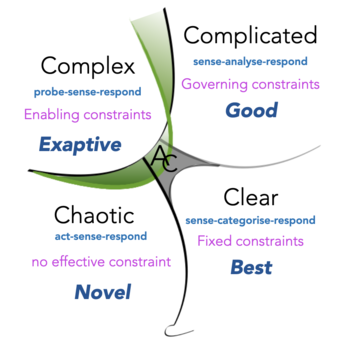Cynefin Domains
Cynefin® is at its heart a decision support framework that is based on the principle of bounded applicability: there are few, if any, context-free solutions but many valid context-specific ones. As such, Cynefin® is a framework, not a method. It is a way of determining what method or approach you should adopt and, critically, when you should change it. Movement between domains can take many forms and these have been represented in the past as dynamics.
The most stable is a constant iteration between Complex and Complicated with some material being consigned to Clear when there is sufficient stability to warrant it and the shift is low risk. Occasionally, there is a need to dip into the aporetic liminal area from Complicated if pattern entrainment has set in (formerly know as a shallow dive into chaos). The aporetic liminal area is also the normal target for an exit from involuntary Chaos. Additionally, there is a dynamic which constantly moves from Complexity through all liminal domains and then back again.
This page reviews the domains shown in different iterations of the Cynefin® framework.
Three primary domains
At its heart there are three primary domains: order, complexity and chaos, defined by the type of constraint, or absence thereof. Order is constrained to the point where future outcomes are predictable as long as the constraints can be sustained. Chaos is the absence of effective constraint, while Complex has enabling constraints, many levels of entanglement that make it dispositional in nature with no linear material causality. The shifts between the primary domains are all phase shifts for which the best metaphor is latent heat - energy is required to achieve the phase shift from liquid to gas, even though the temperature does not change. Similarly going from liquid to solid gives off energy. The boundary between order and chaos is portrayed as a catastrophic fold. The use of un-order as a collective name for Complex and Chaotic is now deprecated.
The central domain of confusion & aporia
If we continue the metaphor of solid, liquid and gas, then we can use the idea of the triple point, the balance of temperature and pressure which means it is equi-probable that the system can move into one of the three states - in Cynefin® that is the central domain of confusion which is frequently, but wrongly (sic) confused with Chaos. This is the area in which we create aporia which allow us to escape in whole or part from confusion. To be unknowingly in the Confused domain is not advisable and it is adjacent to the catastrophic fold for a reason.
The liminal aspect of the confused domain is known, from March 2020 as the aporetic and is seen as key to understanding Cynefin, to using Cynefin, to make decisions where the problem sites in many domains. The aporetic liminal allows an issue to be broken down to its lowest level of coherence and then moved out of the aporetic in one of four possible moves. [1].
Two aspects of order
To accommodate the disconnect between reality, perception and knowledge in human systems, Order in Cynefin® divides into two domains: Clear (where the relationship between cause and effect is self-evident and clear to any reasonable person and constraints are rigid or fixed) and Complicated (where, while the relationship between cause and effect exists, discovering it requires expertise or analysis and the constraints are governing, giving confidence in the boundary of expertise).
Liminality
The liminal line in Cynefin® is open at the top, closed at the bottom and intersects all domains but Clear. The boundary between Clear and Chaotic is a catastrophic fold, or cliff, a collapse where the liminality in Clear is not visible and it is all too easy to walk blindly off the cliff through excessive confidence in the applicability of rigid constraints. The line creates liminal states in Complex (still uncertain but transiting to Complicated), Chaos (the deliberate removal of effective constraints for decision support and/or innovation), Complicated (where the analysis method or type of expertise is in question) and Confusion itself, which is the area of aporia. To be unknowingly in the Confused domain is not advisable and it is adjacent to the catastrophic fold for a reason. To be in a state of confusion, authentically, with knowledge of the state means that aporia can be created to exit into any domain other than Clear.
Practice types
There are different types of practices in each of the Cynefin® domains and liminal areas. In the Complex domain practice is exaptive, or focused on radical re-purposing of existing capability. In the complicated domain we apply good practice. In Clear we have the only legitimate application of best practice. In the liminal area between Complex and Complicated practice is iterative in nature, seeking to establish good practice through a phase shift and this will require energy. In Chaos, practice is generally novel, either by accident, or (in the liminal area) by design. In the liminal area of Confused practice is aporetic, the deliberate creation of paradox and puzzlement to get people to think differently. No type of practice is universal, the summary here is the main focus for action.
Examples
| “ | The carnival is my favourite example. Here, anything goes. You can dress in bells and animal skins, paint your face with ashes and dance in the streets. You can slap the mayor. Your granny can sing the most bawdy of songs without blinking. But only here, and only now, and then it’s over | ” |
| — Elmi Bester, https://members.thecynefin.co/post/staring-into-the-abyss-an-exploration-of-chaos-by-anna-panagiotou-62dfc9cdfbad0ec932e8cd50 | ||
- Clear: The checklist of items that are not allowed in your hand luggage when boarding a plane
- Complicated: The engineering process of building a bridge
- Complex: A childrens' party
- Chaos: Carnival is an example.
References
https://thecynefin.co/cynefin-st-davids-2022-1-of-2/ https://www.youtube.com/watch?v=N7oz366X0-8&t=72s https://www.youtube.com/watch?v=Miwb92eZaJg&t=56s
